Exploring a Self-Sufficiency Approach within a Sustainable Integrated Pisciculture Farming System
Abstract
1. Introduction
1.1. Enhancing Farm Autonomy, Self-Sufficiency and Waste Management Strategies
1.2. Self-Sustaining Agricultural Practices
1.3. Approaches towards Sustainable, Resilient and Innovative Systems in Fish Farming
1.4. Current Integration of Renewable Energy in Aquaculture Practices
2. Materials and Methods
2.1. Self-Sufficient and Sustainable Farming System and Model Design
2.2. Equipment and Resources Required for the Experimental Fish Pond
2.2.1. Power Requirements Analysis and Designing Energy Consumption Plan
2.2.2. Power Production and Energy Storage Installations
2.2.3. The Effect of Locally Produced Feed on the Growth of Three Carp Species
2.2.4. Assessment of Statistically Significant Differences among Feed Recipes
2.3. Water and Sludge Management and Conservation
2.4. Economic Viability
2.5. Composting Phase for Ecological Waste Management and Fertilizer Production
3. Results
3.1. Power Requirements Analysis for Fish Pond Operations and Energy Consumption Plan Design
3.2. Power Production and Energy Storage
3.3. Self-Sustaining Feed Production System for Raising Carp in Fish Ponds
3.4. Assessment of Statistically Significant Differences among Feed Recipes
3.5. Developing an Evaluation Model to Assess the Self-Sustainability of the Aquaculture System
4. Discussion
5. Conclusions
Author Contributions
Funding
Institutional Review Board Statement
Informed Consent Statement
Data Availability Statement
Conflicts of Interest
References
- Naylor, R.; Fang, S.; Fanzo, J. A global view of aquaculture policy. Food Policy 2023, 116, 102422. [Google Scholar] [CrossRef]
- Abdul-Rahman, S.; Saoud, I.P.; Owaied, M.K.; Holail, H.; Farajalla, N.; Haidar, M.; Ghanawi, J. Improving Water Use Efficiency in Semiarid Regions through Integrated Aquaculture. In Aquaculture Technology in Developing Countries; Routledge: Oxfordshire, UK, 2011; Volume 23, pp. 212–230. [Google Scholar] [CrossRef]
- Oprescu, M.R.; Biris, S.-S.; Nenciu, F. Novel Furrow Diking Equipment-Design Aimed at Increasing Water Consumption Efficiency in Vineyards. Sustainability 2023, 15, 2861. [Google Scholar] [CrossRef]
- Ahmed, N.; Thompson, S.; Glaser, M. Global aquaculture productivity, environmental sustainability, and climate change adaptability. Environ. Manag. 2019, 63, 159–172. [Google Scholar] [CrossRef] [PubMed]
- Catchpole, T.L.; Enever, R.; Maxwell, D.L.; Armstrong, M.J.; Reese, A.; Revill, A.S. Constructing indices to detect temporal trends in discarding. Fish. Res. 2011, 107, 94–99. [Google Scholar] [CrossRef]
- Mangi, S.C.; Dolder, P.J.; Catchpole, T.L.; Rodmell, D.; de Rozarieux, N. Approaches to fully documented fisheries: Practical issues and stakeholder perceptions. Fish 2015, 16, 426–452. [Google Scholar] [CrossRef]
- Maulu, S.; Hasimuna, O.J.; Haambiya, L.H.; Monde, C.; Musuka, C.G.; Makorwa, T.H.; Munganga, B.P.; Phiri, K.J.; Nsekanabo, J.D. Climate change effects on aquaculture production: Sustainability implications, mitigation, and adaptations. Front. Sustain. Food Syst. 2021, 5, 609097. [Google Scholar] [CrossRef]
- Godfray, H.C.J.; Beddington, J.R.; Crute, I.R.; Haddad, L.; Lawrence, D.; Muir, J.F.; Pretty, J.; Robinson, S.; Thomas, S.M.; Toulmin, A.C. Food security: The challenge of feeding 9 billion people. Science 2010, 327, 812–818. [Google Scholar] [CrossRef]
- Hamidov, A.; Helming, K.; Balla, D. Impact of agricultural land use in Central Asia: A review. Agron. Sustain. Dev. 2016, 36, 6. [Google Scholar] [CrossRef]
- Bekchanov, M.; Karimov, A.; Lamers, J.P.A. Impact of water availability on land and water productivity: A temporal and spatial analysis of the case study region Khorezm, Uzbekistan. Water 2010, 2, 668–684. [Google Scholar] [CrossRef]
- Ciobotaru, I.E.; Nenciu, F.; Vaireanu, D.I. The Electrochemical Generation of Ozone using an Autonomous Photovoltaic System. Rev. Chim. 2013, 64, 1339–1342. [Google Scholar]
- Ibrahim, L.A.; Abu-Hashim, M.; Shaghaleh, H.; Elsadek, E.; Hamad, A.A.A.; Alhaj Hamoud, Y. A Comprehensive Review of the Multiple Uses of Water in Aquaculture-Integrated Agriculture Based on International and National Experiences. Water 2023, 15, 367. [Google Scholar] [CrossRef]
- Nenciu, F.; Oprescu, M.R.; Biris, S.-S. Improve the Constructive Design of a Furrow Diking Rotor Aimed at Increasing Water Consumption Efficiency in Sunflower Farming Systems. Agriculture 2022, 12, 846. [Google Scholar] [CrossRef]
- Sainsbury, K.J.; Punt, A.E.; Smith, A.D.M. Design of operational management strategies for achieving fishery ecosystem objectives. ICES J. Mar. Sci. 2000, 57, 731–741. [Google Scholar] [CrossRef]
- Bathaei, A.; Štreimikienė, D. Renewable Energy and Sustainable Agriculture: Review of Indicators. Sustainability 2023, 15, 14307. [Google Scholar] [CrossRef]
- Ioakeimidis, C.; Polatidis, H.; Haralambopoulos, D. Use of renewable energy in aquaculture: An energy audit case-study analysis. Glob. NEST J. 2013, 15, 282–294. [Google Scholar]
- Pueppke, S.G.; Nurtazin, S.; Ou, W. Water and Land as Shared Resources for Agriculture and Aquaculture: Insights from Asia. Water 2020, 12, 2787. [Google Scholar] [CrossRef]
- D’Odorico, P.; Davis, K.F.; Rosa, L.; Carr, J.A.; Chiarelli, D.; Dell’Angelo, J.; Gephart, J.; MacDonald, G.K.; Seekell, D.A.; Suweis, S.; et al. The global food-energy-water nexus. Rev. Geophys. 2018, 56, 456–531. [Google Scholar] [CrossRef]
- Simpson, G.B.; Jewitt, G.P.W. The water-energy-food nexus in the Anthropocene: Moving from ‘nexus thinking’ to ‘nexus action. Curr. Opin. Environ. Sust. 2019, 40, 117–123. [Google Scholar] [CrossRef]
- Geressu, R.; Siderius, C.; Harou, J.J.; Kashaigili, J.; Pettinotti, L.; Conway, D. Assessing River basin development given water-energy-food-environment interdependencies. Earth’s Future 2020, 7, e2019EF001464. [Google Scholar] [CrossRef]
- Bommarco, R.; Kleijn, D.; Potts, S.G. Ecological intensification: Harnessing ecosystem services for food security. Trends Ecol. Evol. 2013, 28, 230–238. [Google Scholar] [CrossRef] [PubMed]
- de Roest, K.; Ferrari, P.; Knickel, K. Specialisation and economies of scale or diversification and economies of scope? Assessing different agricultural development pathways. J. Rural. Stud. 2018, 59, 222–231. [Google Scholar] [CrossRef]
- Ferguson, R.S.; Lovell, S.T. Diversification and labor productivity on US permaculture farms. Renew. Agric. Food Syst. 2019, 34, 326–337. [Google Scholar] [CrossRef]
- Wang, P.; Mendes, I.; Franić, R. Investigating the Relationship between Aquaculture Investments, Training, and Environmental Factors in Guangdong: An Alternative Perspective. Fishes 2023, 8, 237. [Google Scholar] [CrossRef]
- Kroetz, K.; Sanchirico, J.N.; Lew, D.K. Efficiency costs of social objectives in tradable permit programs. J. Assoc. Environ. Resour. Econ. 2015, 2, 339–366. [Google Scholar] [CrossRef]
- Tittensor, D.P.; Walpole, M.; Hill, S.L.; Boyce, D.G.; Britten, G.L.; Burgess, N.D.; Butchart, S.H.; Leadley, P.W.; Regan, E.C.; Alkemade, R. A mid-term analysis of progress toward international biodiversity targets. Science 2014, 346, 241–244. [Google Scholar] [CrossRef]
- McCauley, D.J.; Pinsky, M.L.; Palumbi, S.R.; Estes, J.A.; Joyce, F.H.; Warner, R.R. Marine defaunation: Animal loss in the global ocean. Science 2015, 347, 1255641. [Google Scholar] [CrossRef]
- Stafford, R. Sustainability: A flawed concept for fisheries management? Elem. Sci. Anthr. 2019, 7, 8. [Google Scholar] [CrossRef]
- Prellezo, R.; Curtin, R. Confronting the imple¬mentation of marine ecosystem-based management within the Common Fisheries Policy reform. Ocean. Coast. Manag. 2015, 117, 43–51. [Google Scholar] [CrossRef]
- Nilsson, J.A.; Fulton, E.A.; Johnson, C.R.; Haward, M. How to Sustain Fisheries: Expert Knowledge from 34 Nations. Water 2019, 11, 213. [Google Scholar] [CrossRef]
- Worm, B.; Barbier, E.B.; Beaumont, N.; Duffy, J.E.; Folke, C.; Halpern, B.S.; Jackson, J.B.; Lotze, H.K.; Micheli, F.; Palumbi, S.R. Impacts of biodiversity loss on ocean ecosystem services. Science 2006, 314, 787–790. [Google Scholar] [CrossRef]
- Fulton, E.A.; Link, J.S.; Kaplan, I.C.; Savina-Rolland, M.; Johnson, P.; Ainsworth, C.; Horne, P.; Gorton, R.; Gamble, R.J.; Smith, A.D.M.; et al. Lessons in modelling and management of marine ecosystems: The Atlantis experience. Fish Fish. 2011, 12, 171–188. [Google Scholar] [CrossRef]
- Nenciu, F.; Voicea, I.; Stefan, V.; Nae, G.; Matache, M.; Milian, G.; Arsenoaia, V.N. Experimental research on a feed pelletizing equipment designed for small and medium-sized fish farms. INMATEH Agric. Eng. 2022, 67, 374–383. [Google Scholar] [CrossRef]
- Ogunjuyigbe, A.; Ayodele, T.; Ogunmuyiwa, S. Improving electrical energy utilization in some selected Nigerian food and beverage industries. Sustain. Energy Technol. Assess. 2015, 12, 38–45. [Google Scholar] [CrossRef]
- Rafiei, M.; Ricardez-Sandoval, L.A. A trust-region framework for integration of design and control. AICHE J. 2020, 66, e16922. [Google Scholar] [CrossRef]
- Recalde, L.; Yue, H.; Leithead, W.; Anaya-Lara, O.; Liu, H.; You, J. Hybrid renewable energy systems sizing for offshore multi-purpose platforms. In Proceedings of theInternational Conference on Offshore Mechanics and Arctic Engineering, Glasgow, UK, 9–14 June 2019; American Society of Mechanical Engineers: New York, NY, USA, 2019; p. V010T09A059. [Google Scholar]
- Nguyen, N.T.; Matsuhashi, R. A design on sustainable hybrid energy systems by multi-objective optimization for aquaculture industry. Renew. Energy 2021, 163, 1878–1894. [Google Scholar] [CrossRef]
- Laine, C.; Ollikainen, M.; Kankainen, M.; Setala, J.; Vielma, J. Social net benefits from aquaculture production: A comparison of net cage cultivation and recirculating aquaculture systems. Aquac. Econ. Manag. 2023, 28, 1–31. [Google Scholar] [CrossRef]
- Badiola, M.; Basurko, O.C.; Piedrahita, R.; Hundley, P.; Mendiola, D. Energy use in recirculating aquaculture systems (RAS): A review. Aquac. Eng. 2018, 81, 57–70. [Google Scholar] [CrossRef]
- Przybyl, A.; Mazurkiewicz, J. Nutritive value of cereals in feeds for common carp (Cyprinus carpio L.). Czech J. Anim. Sci. 2004, 49, 307–314. [Google Scholar] [CrossRef]
- Viola, S.; Arieli, Y. Evaluation of different grains as basic ingredients in complete feeds for carp and tilapia in intensive culture. Bamidgeh 1983, 35, 38–42. [Google Scholar]
- Marković, Z.; Stanković, M.; Rašković, B.; Dulic, Z.; Zivic, I.; Poleksic, V. Comparative analysis of using cereal grains and compound feed in semi-intensive common carp pond production. Aquac. Int. 2016, 24, 1699–1723. [Google Scholar] [CrossRef]
- Scroggins, R.E.; Fry, J.P.; Brown, M.T.; Neff, R.A.; Asche, F.; Anderson, J.L.; Love, D.C. Renewable energy in fisheries and aquaculture: Case studies from the United States. J. Clean. Prod. 2022, 376, 134153. [Google Scholar] [CrossRef]
- Davis-Sramek, B. Corporate “green gold”: State policy implications for wind and solar energy buyers. Bus. Horiz. 2021, 64, 347–360. [Google Scholar] [CrossRef]
- Withouck, I.; Tett, P.; Doran, J.; Mouat, B.; Shucksmith, R. Diving into a just transition: How are fisheries considered during the emergence of renewable energy production in Scottish waters? Energy Res. Soc. Sci. 2023, 101, 103135. [Google Scholar] [CrossRef]
- Vo, T.T.E.; Ko, H.; Huh, J.-H.; Park, N. Overview of Solar Energy for Aquaculture: The Potential and Future Trends. Energies 2021, 14, 6923. [Google Scholar] [CrossRef]
- Nenciu, F.; Fatu, V.; Arsenoaia, V.; Persu, C.; Voicea, I.; Vladut, N.-V.; Matache, M.G.; Gageanu, I.; Marin, E.; Biris, S.-S.; et al. Bioactive Compounds Extraction Using a Hybrid Ultrasound and High-Pressure Technology for Sustainable Farming Systems. Agriculture 2023, 13, 899. [Google Scholar] [CrossRef]
- Mahmudov, K.; Mahmoud, A.; Sur, S.; Cruz, F.C.; Bilton, A.M. Feasibility of a wind-powered aeration system for small-scale aquaculture in developing countries. Energy Sustain. Dev. 2019, 51, 40–49. [Google Scholar] [CrossRef]
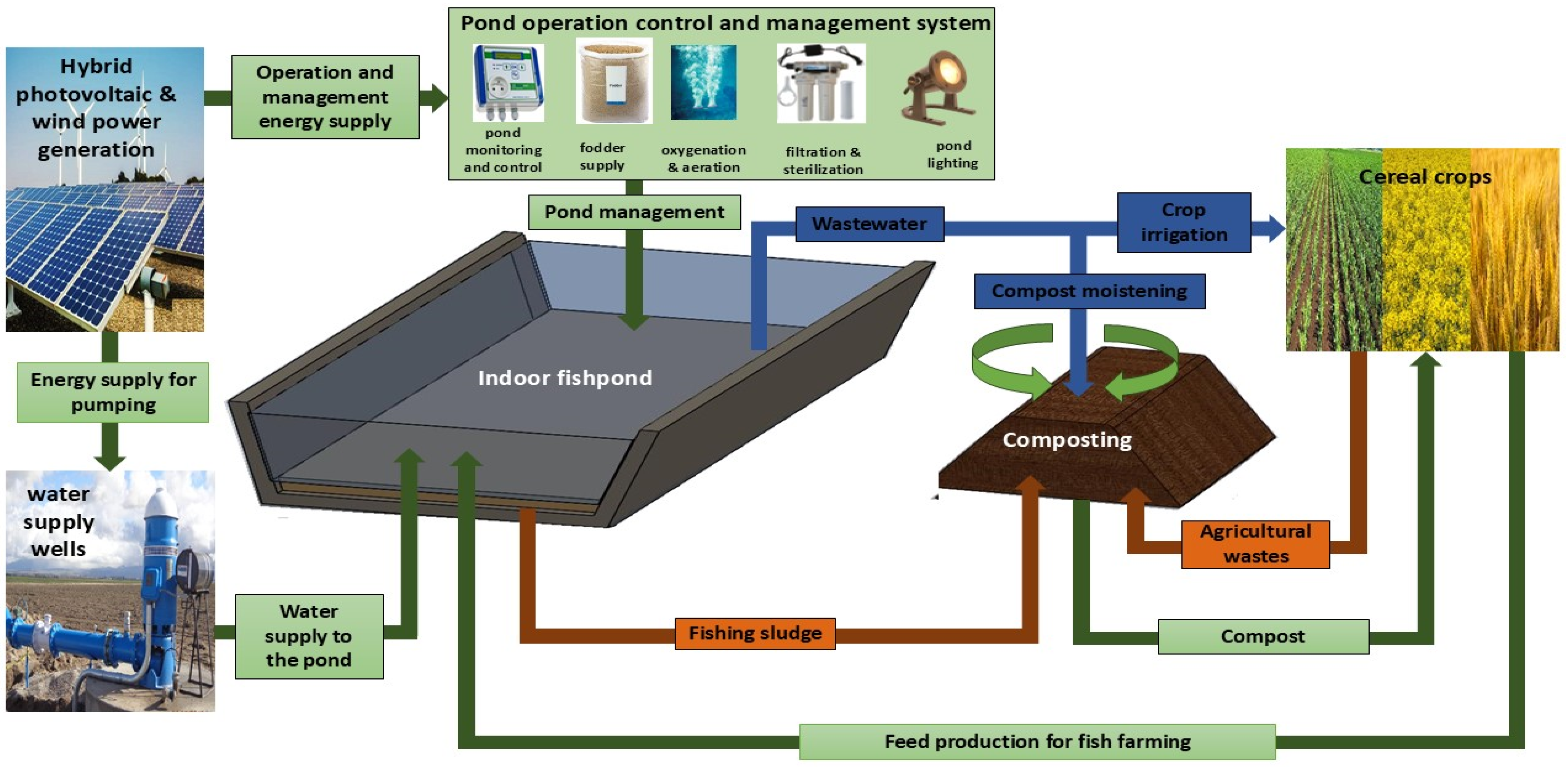
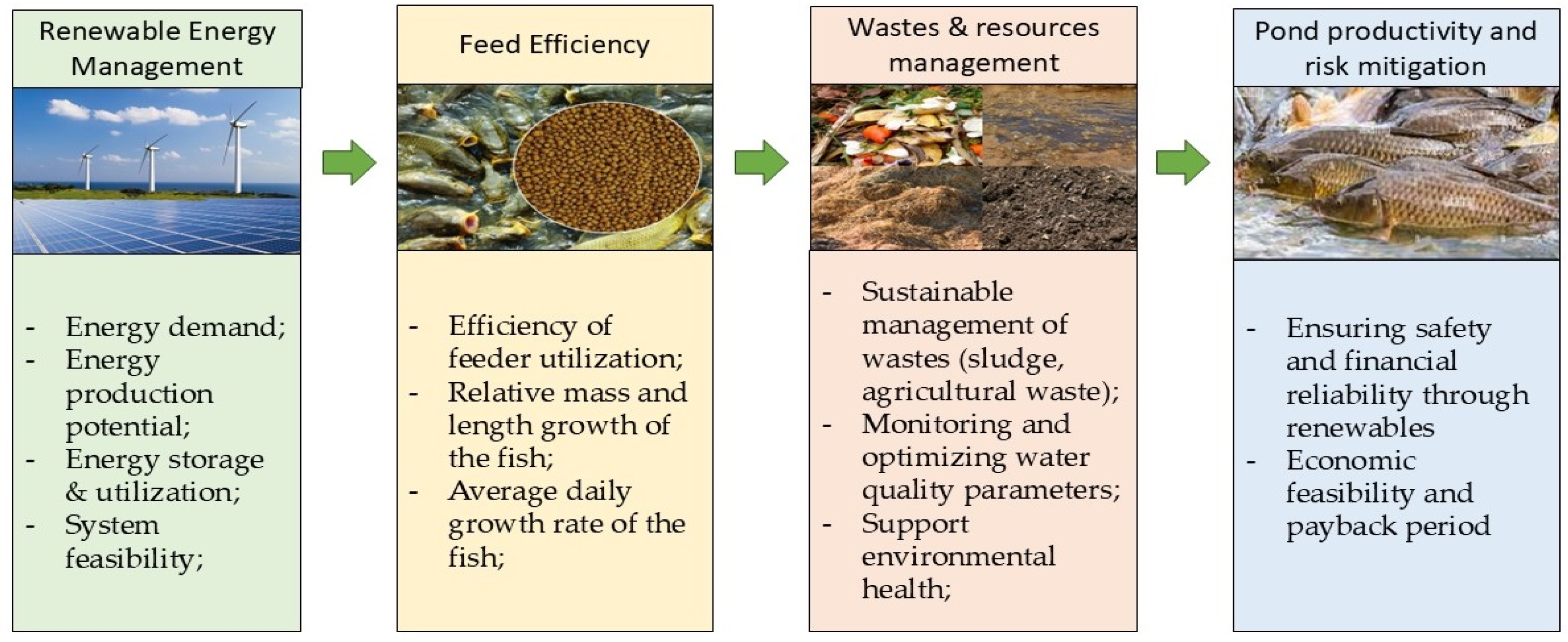

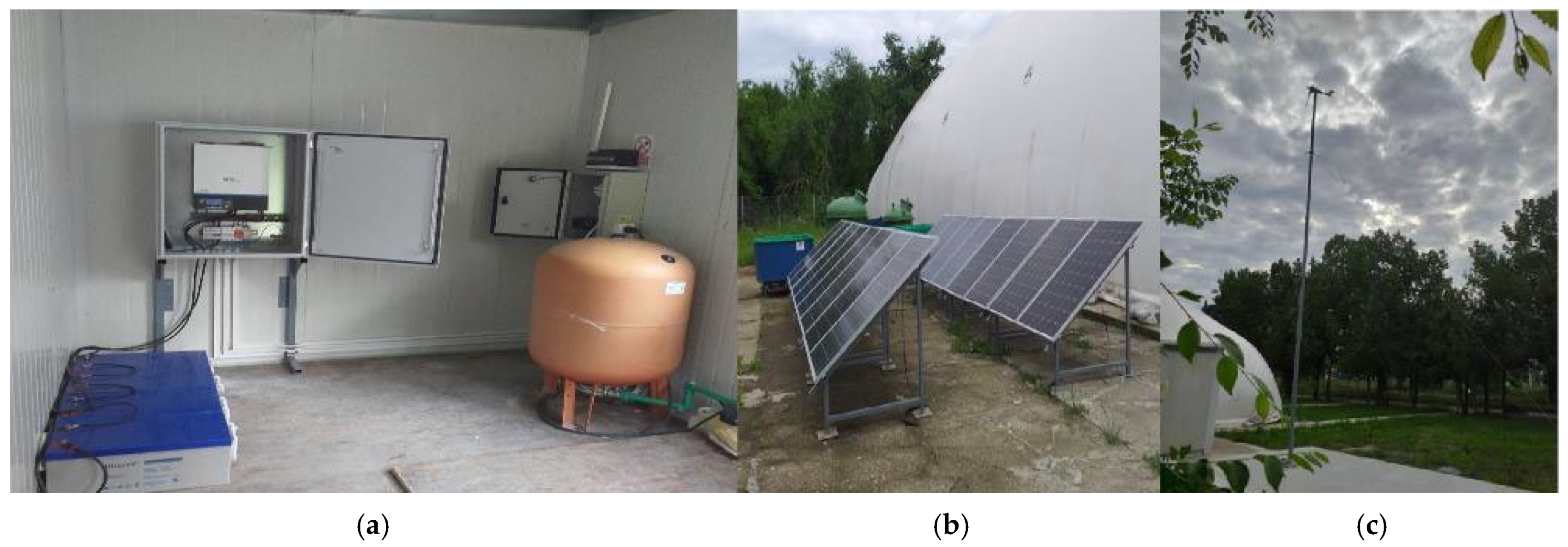

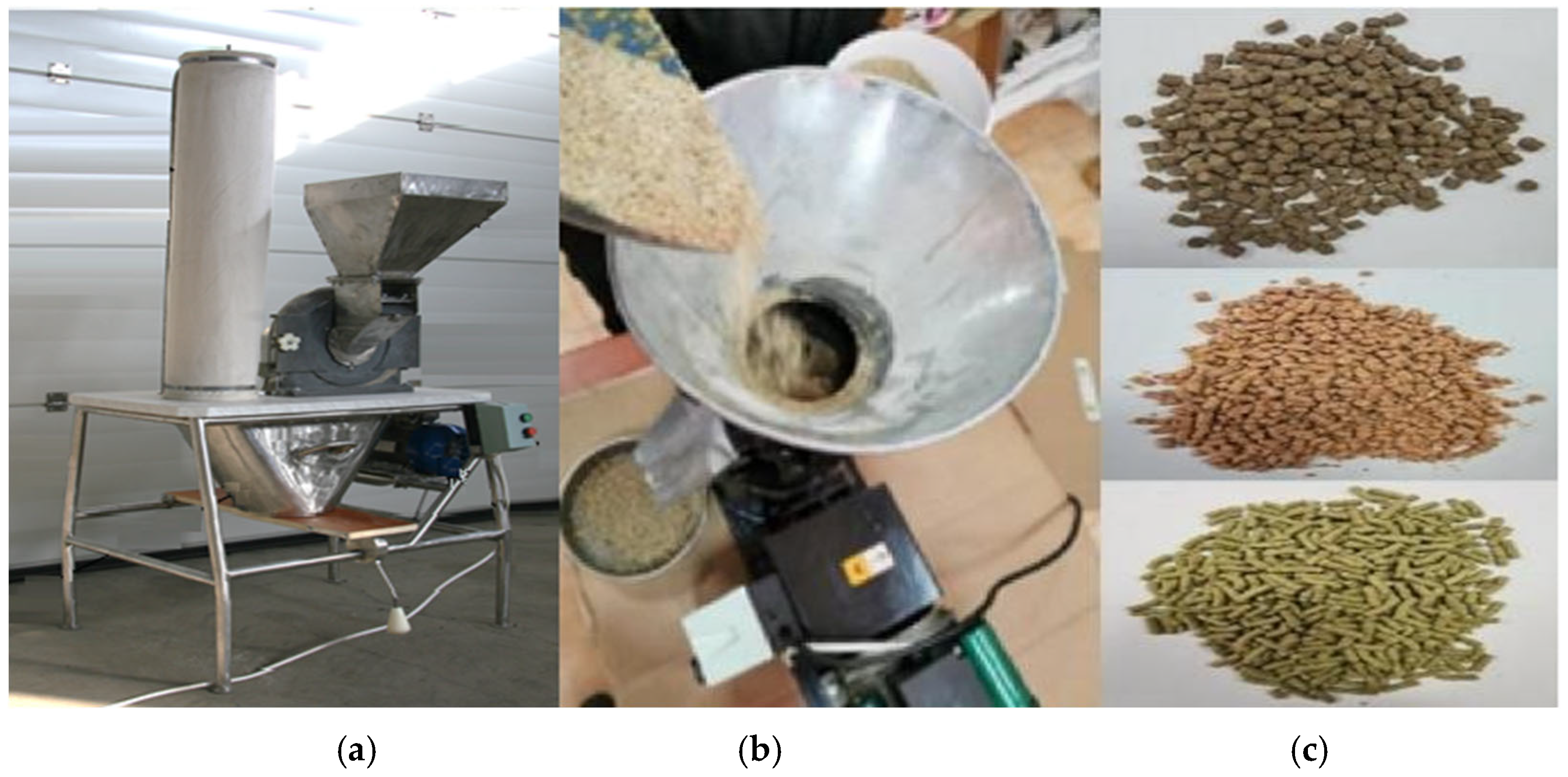


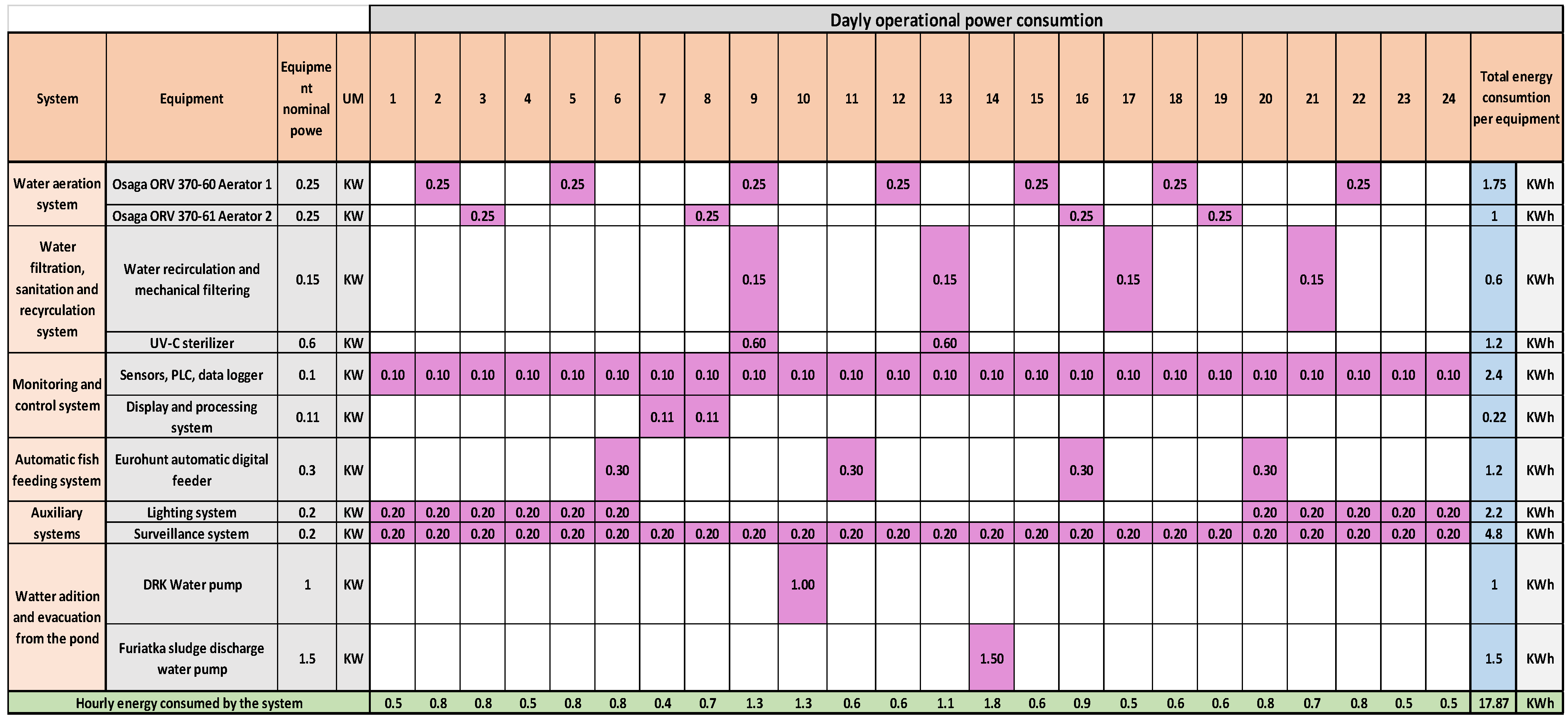
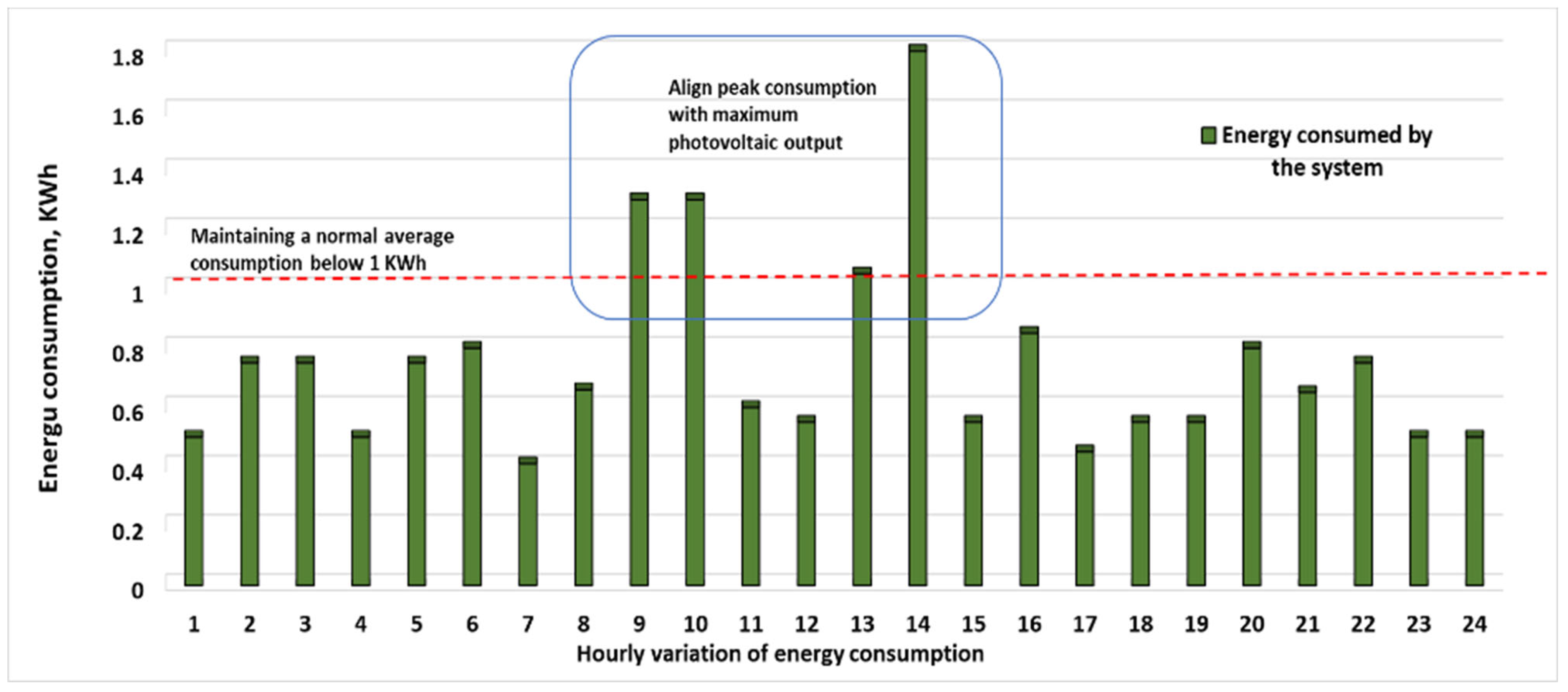
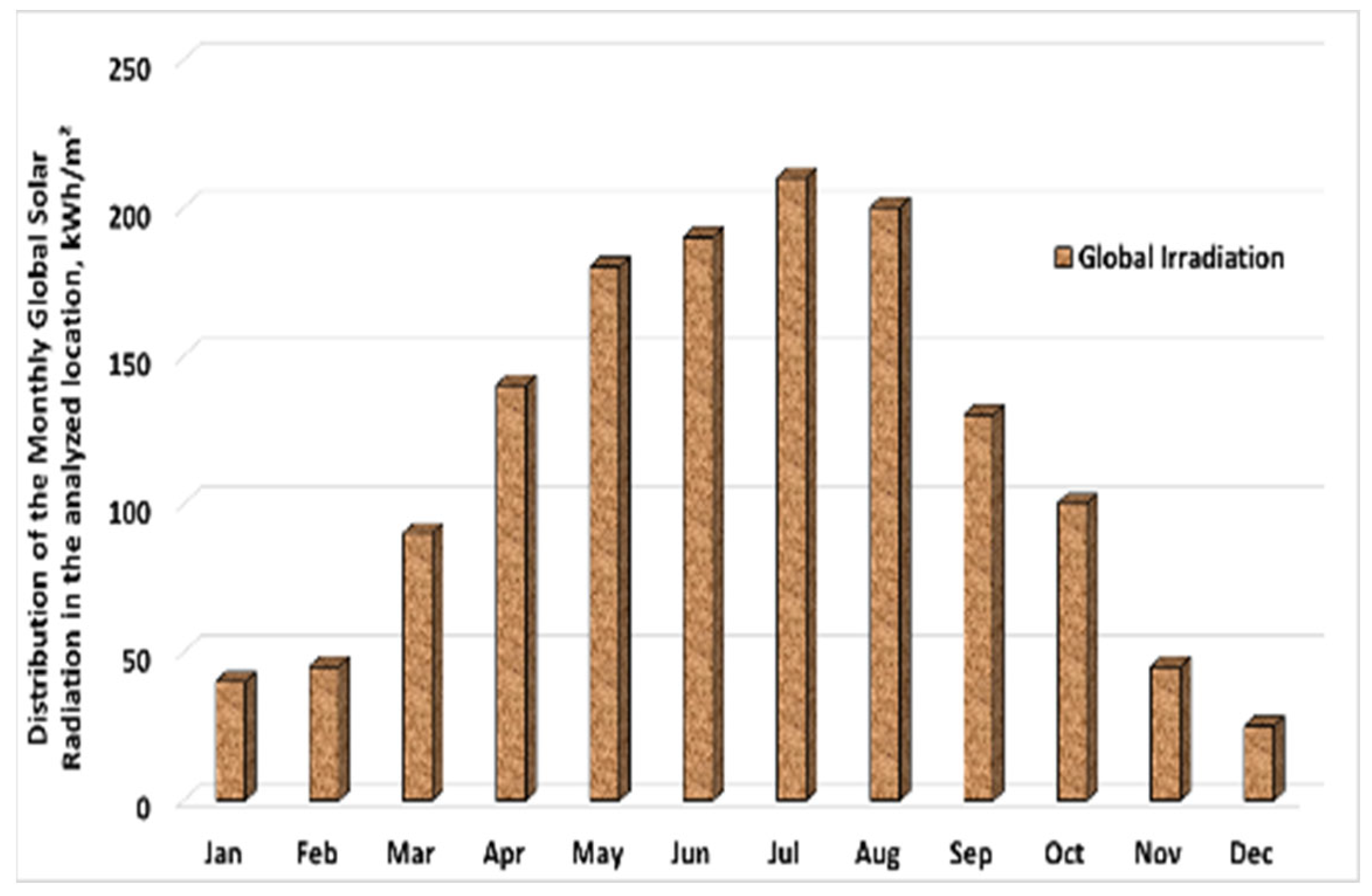
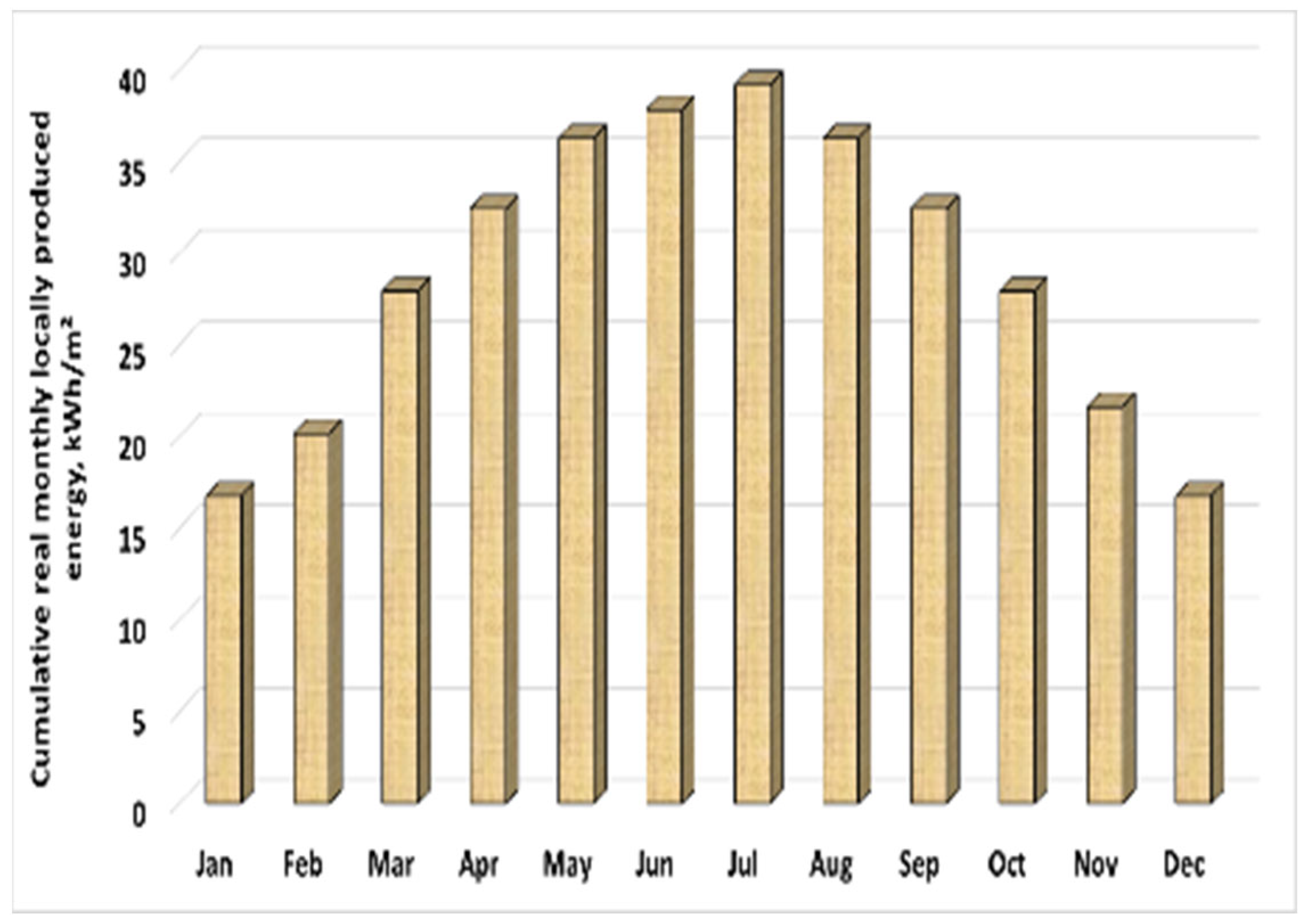
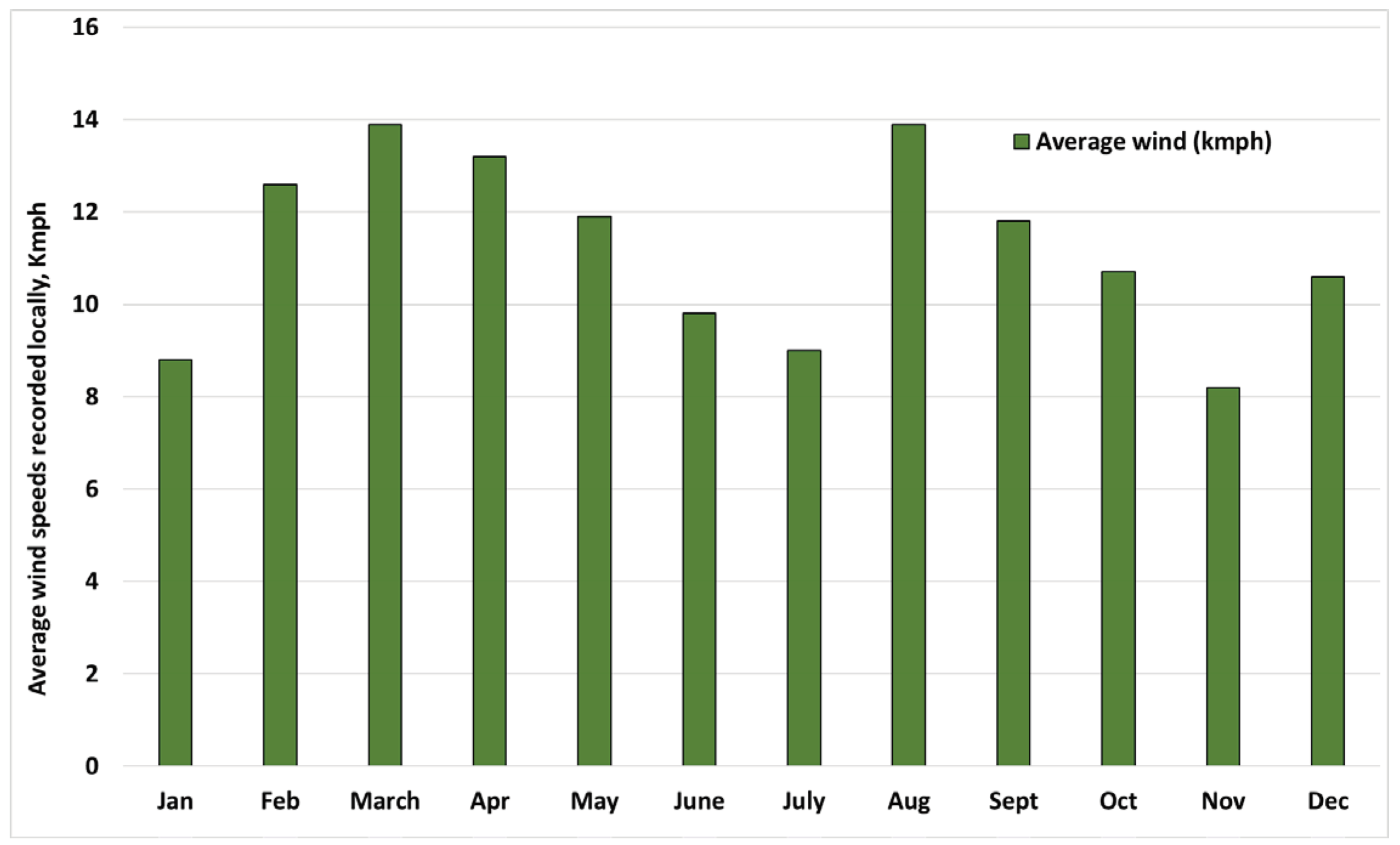
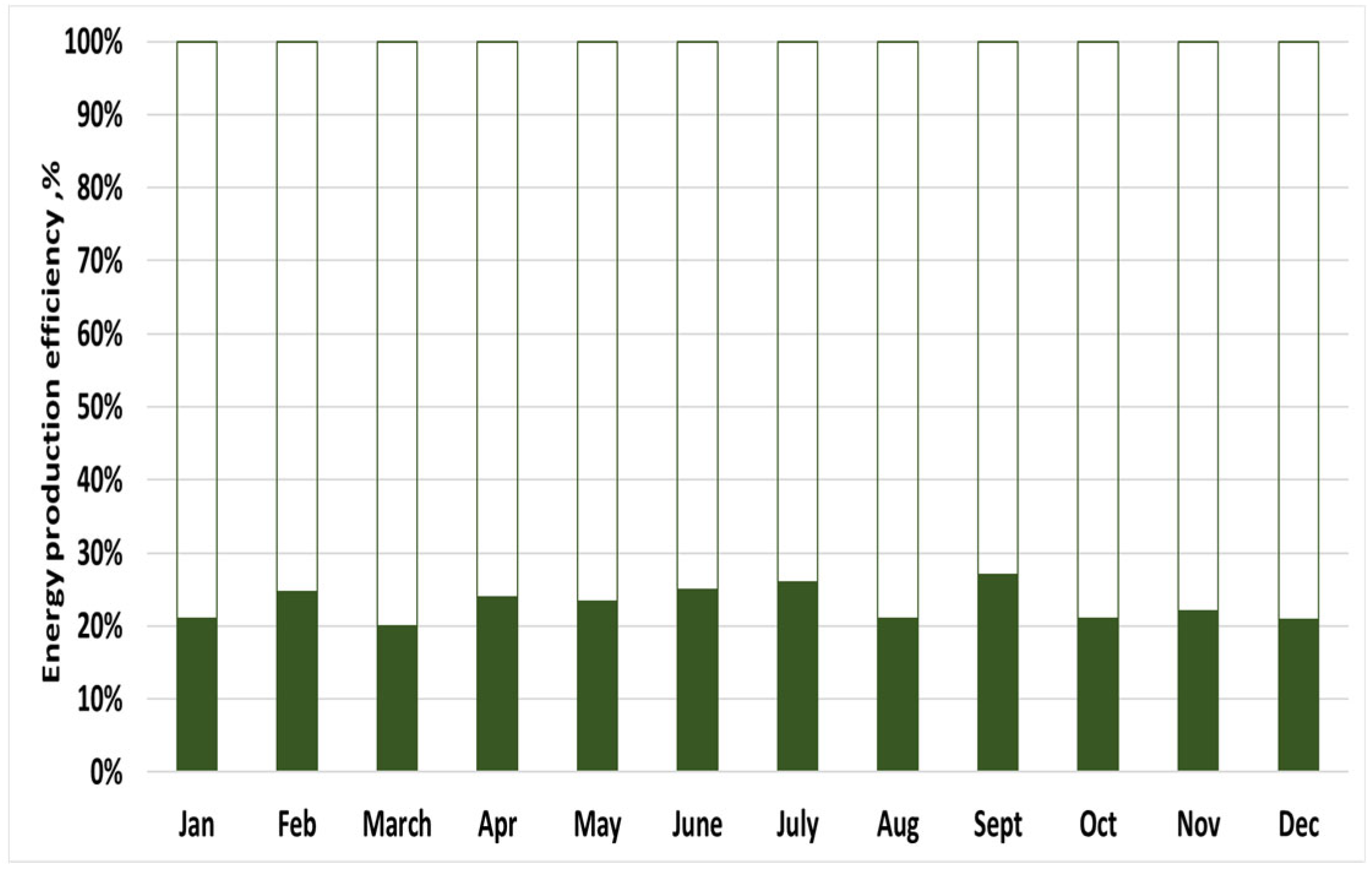
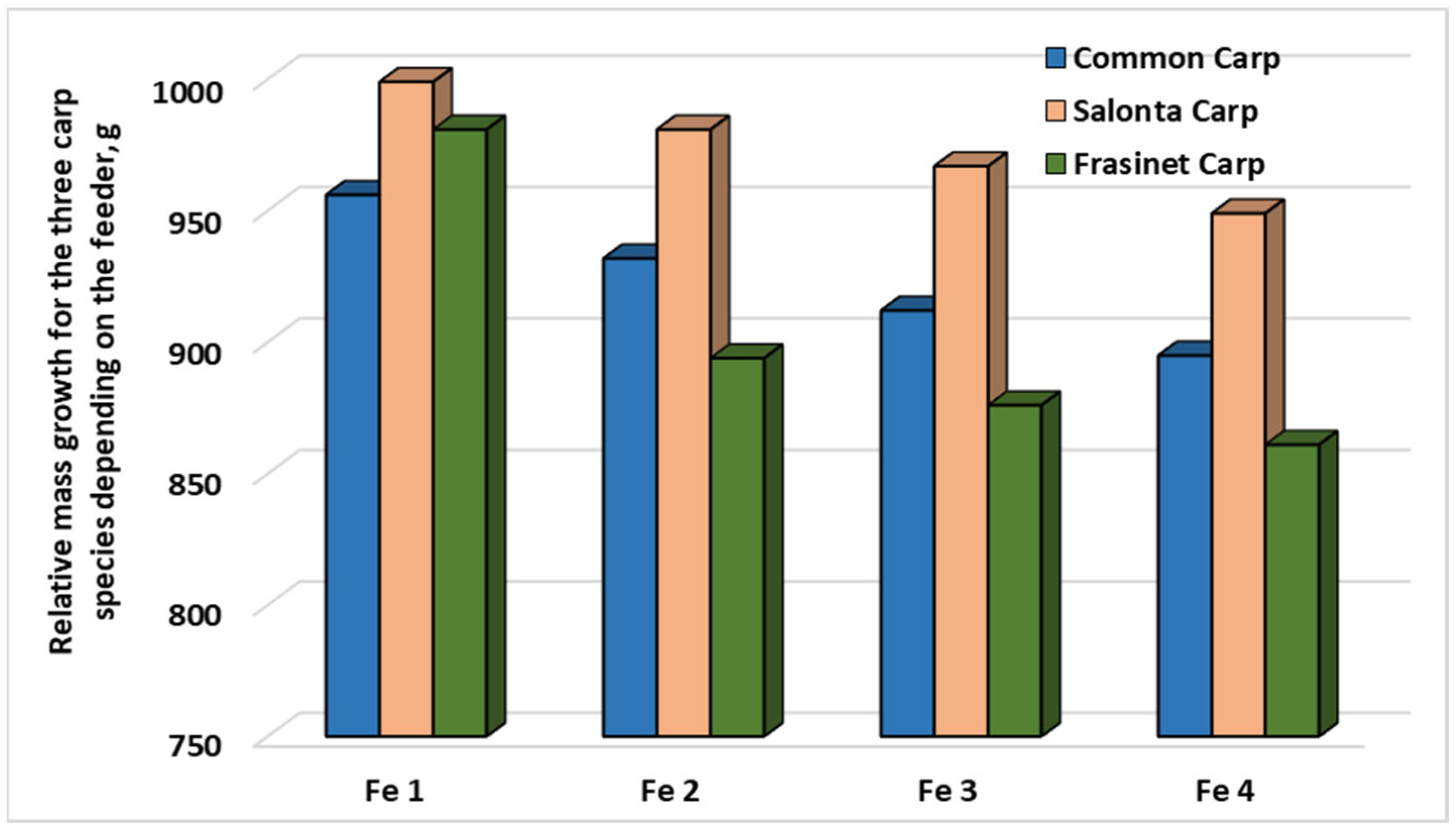
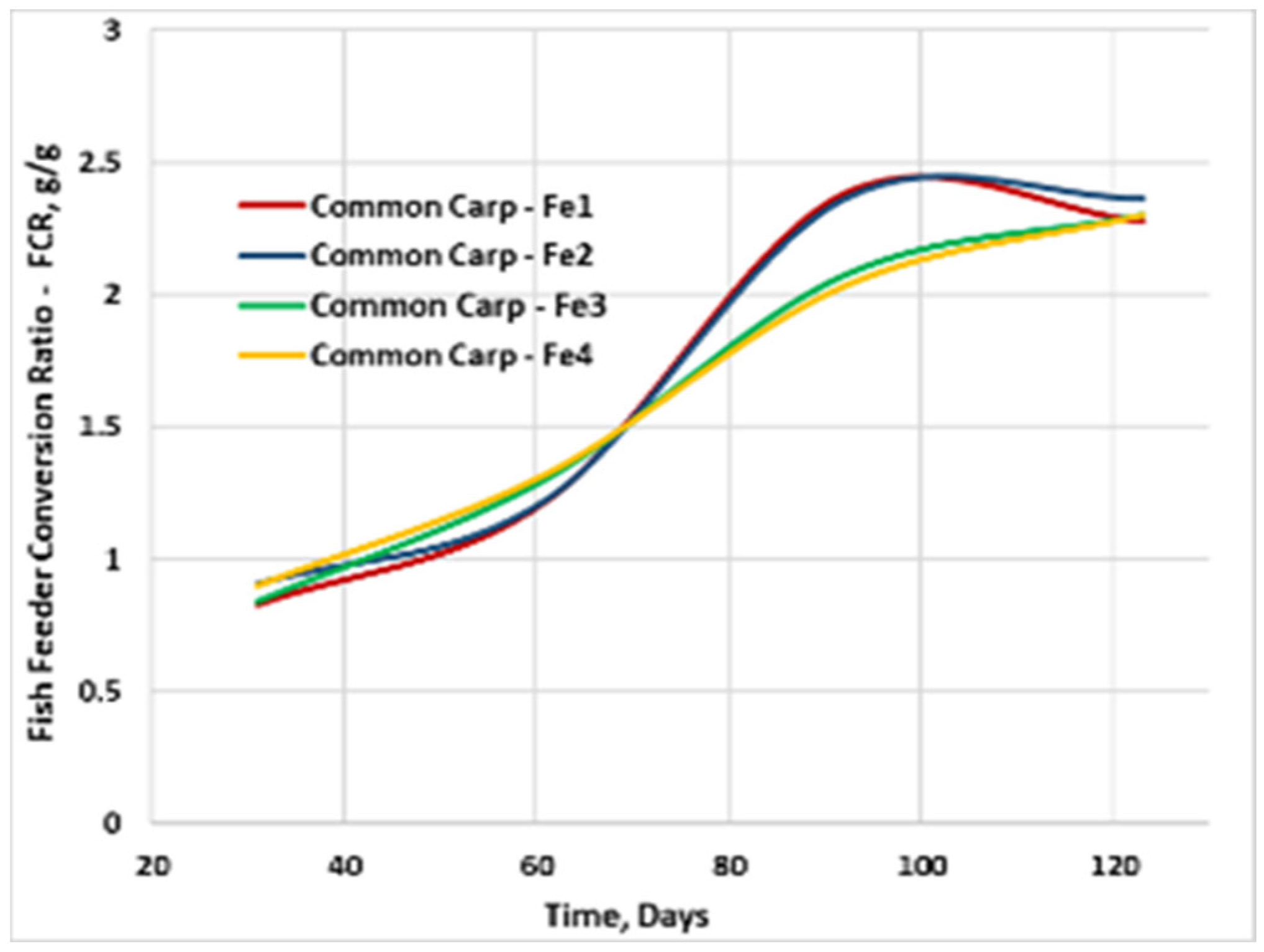
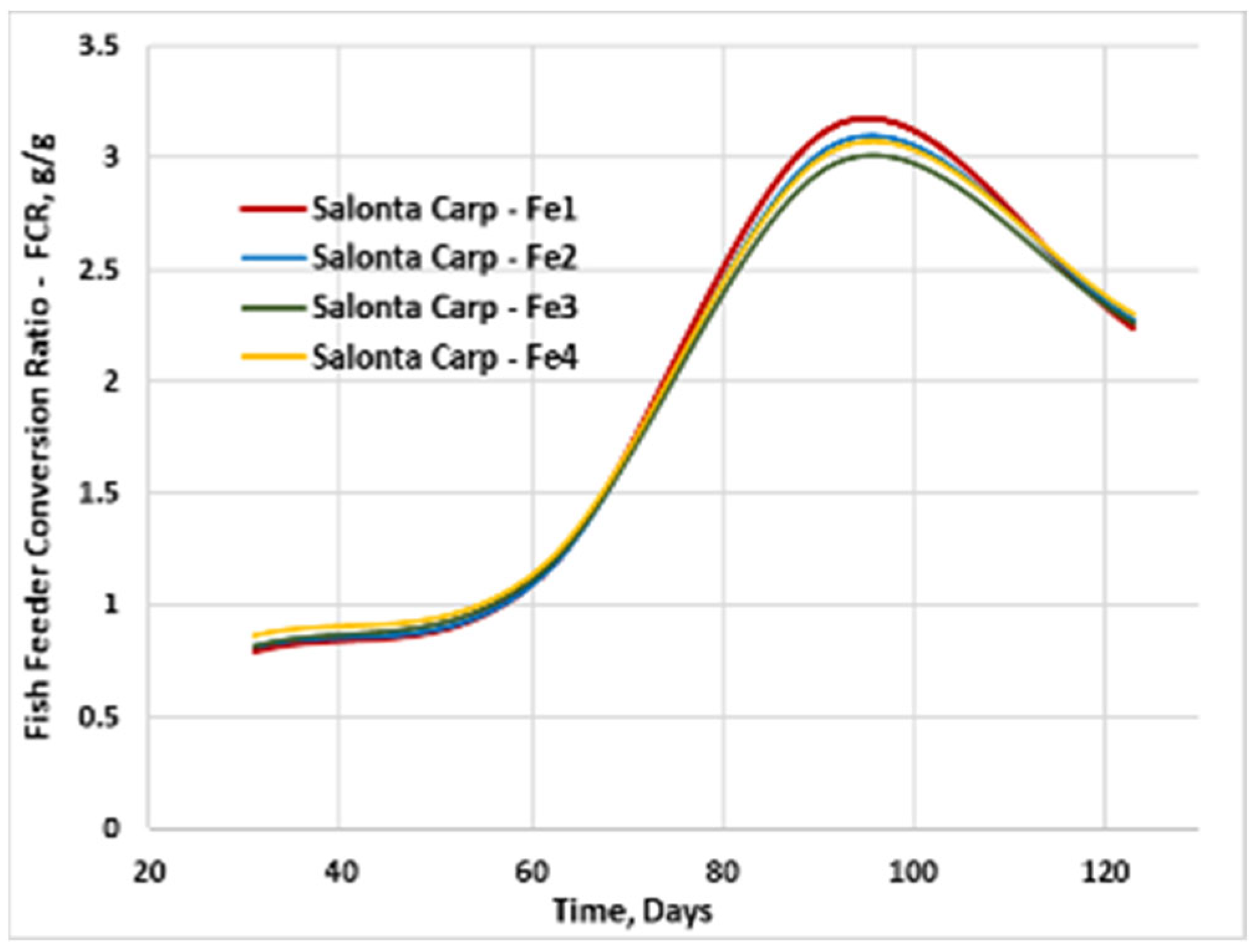
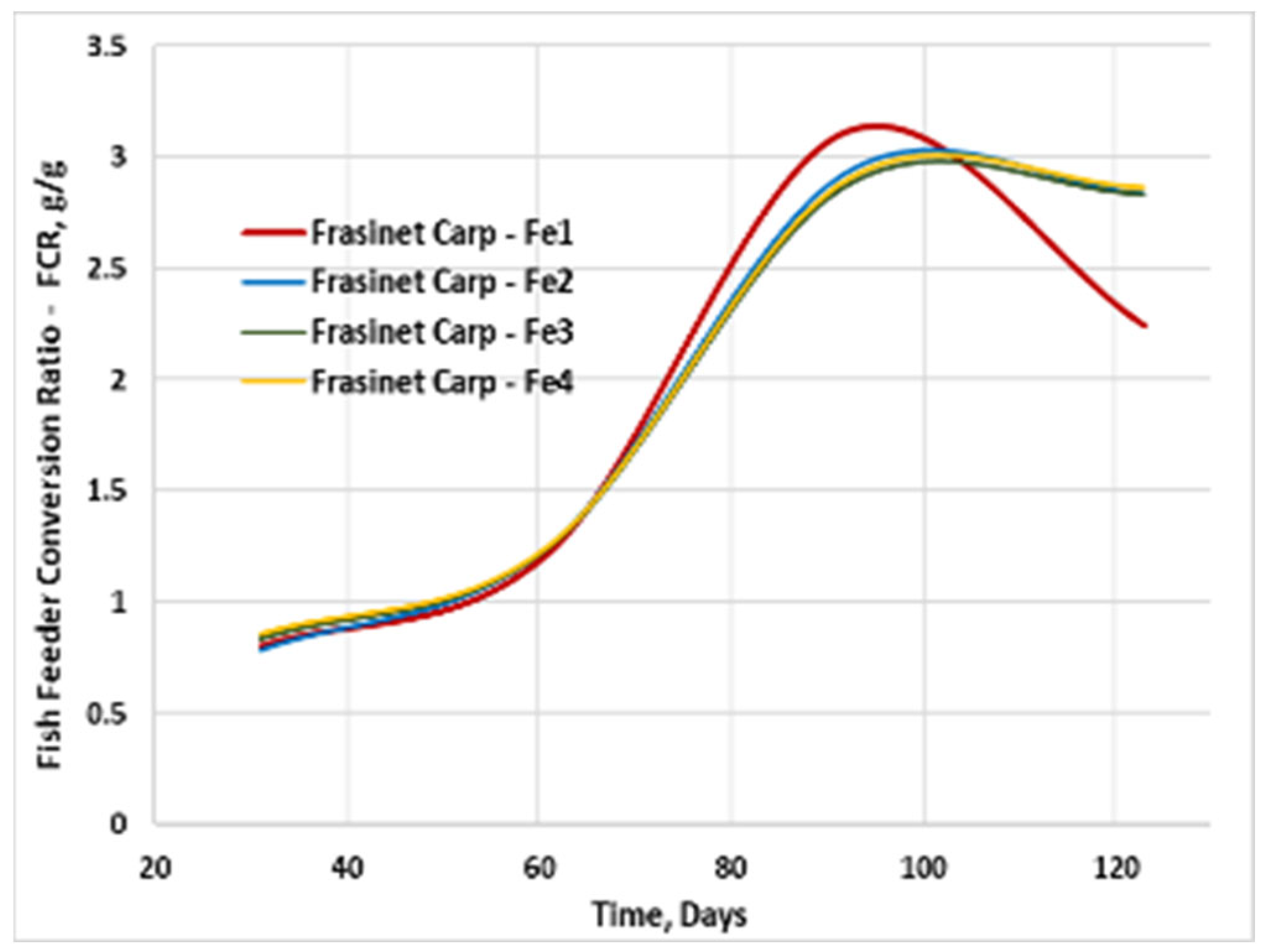
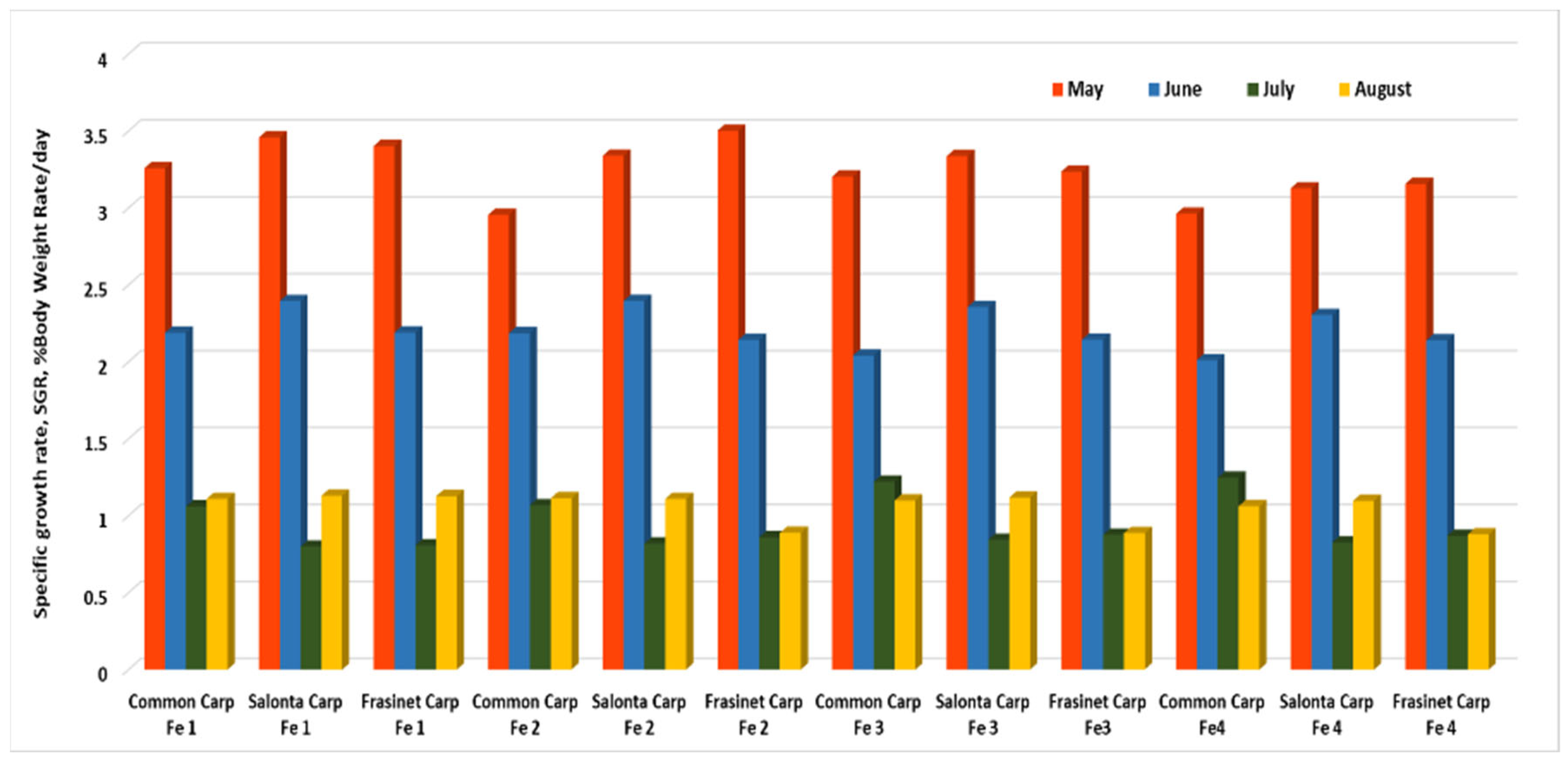
| Indicators Achieved to Meet Sustainability and Self-Sustaining Requirements | Grading * | ||||||
|---|---|---|---|---|---|---|---|
| Objectives | Indicator | Requirement Fulfillment | 1 | 2 | 3 | 4 | 5 |
| Resource Efficiency | Energy Use | -Highly efficient in energy consumption, providing a customized consumption regime that flattens power consumption peaks; -Renewable energy sources such (hybrid photovoltaic–wind turbines, coupled with energy storage system for safety. | |||||
| Water Utilization | -The wastewater coming from fish farming is used entirely for irrigation in agriculture, and there is no pollution of the emissary (rivers); -Due to the special construction of the fishing pond (waterproof reinforced concrete), there is no pollution of the underground waters; -There is high efficiency in using water per unit of food and endowments regarding water recycling and purification systems. | ||||||
| Nutrient Management | -Feed produced locally using local technology and ingredients demonstrates fish growth comparable to that achieved with purchased feed; -Wastes generated from feed production are reintegrated back into the system. | ||||||
| System Reliability | Operational Stability | The system operates consistently under normal and stress conditions, including ability to handle variations in weather, resource availability, and potential system failures. The carp is a species that does not show a high sensitivity to the technological problems that may arise. | |||||
| Low Maintenance Requirements | -Low frequency and cost of maintenance are needed to keep the system functioning optimally. Maintenance costs can increase over time, due to the high level of automation. | ||||||
| Flexibility and Scalability | Adaptability | -The system has an increased ability to adapt to different environments, scales of operation, and changing resource conditions. However, local climatic conditions can negatively influence energy production. | |||||
| Expansion Potential (scale up or down) | -The technology can be scaled up or down to meet varying demands or to integrate into larger production systems. However, there is a strong dependance on several factors such as climatic conditions, type of fish raised, and fertility of the soil for feed production. | ||||||
| Ease of Operation | -Easy for operators to use, with simple management tasks and minimal expertise required. | ||||||
| Integration with Existing Systems | -The system integrates with existing agricultural or energy systems, ensuring compatibility with current infrastructure and technologies. | ||||||
| Productivity | Yield | -Achieving a substantial yield of products and energy relative to the inputs utilized, considering factors such as growth rates, harvest times, and overall productivity per unit volume. | |||||
| Environmental Impact | Carbon Footprint | -Reducing the GHG emissions, including direct and indirect emissions associated with energy use, production processes, and waste management and transportation (compared to conventional systems). | |||||
| Biodiversity and Ecosystem Health | -Highly positive impact on local biodiversity and ecosystem services, including substantial benefits such as reducing surface and underground water pollution and mitigating river nitrification. | ||||||
| Climate Resilience | -Ability to withstand and adapt to climate-related challenges, including extreme weather events and long-term climate change. | ||||||
| Renewability | -Reliance on renewable resources and capacity to minimize depletion of non-renewable resources. | ||||||
| Social Impact | Community Benefits | -System may support local communities, including job creation, food security, and social equity (especially in the production of cereals). However, the increased level of automation reduces the effort with the farm’s labor force, therefore not contributing to the creation of new jobs. | |||||
| Resource Resilience | -High capacity to manage resource scarcity or variability, including fluctuations in energy, water, and nutrient availability | ||||||
| Local Economy | The system contributes to the local economy, including impacts on local businesses, markets, and economic resilience. | ||||||
Disclaimer/Publisher’s Note: The statements, opinions and data contained in all publications are solely those of the individual author(s) and contributor(s) and not of MDPI and/or the editor(s). MDPI and/or the editor(s) disclaim responsibility for any injury to people or property resulting from any ideas, methods, instructions or products referred to in the content. |
© 2024 by the authors. Licensee MDPI, Basel, Switzerland. This article is an open access article distributed under the terms and conditions of the Creative Commons Attribution (CC BY) license (https://creativecommons.org/licenses/by/4.0/).
Share and Cite
Voicea, I.; Nenciu, F.; Vlăduț, N.-V.; Matache, M.-G.; Persu, C.; Cujbescu, D. Exploring a Self-Sufficiency Approach within a Sustainable Integrated Pisciculture Farming System. Sustainability 2024, 16, 8055. https://doi.org/10.3390/su16188055
Voicea I, Nenciu F, Vlăduț N-V, Matache M-G, Persu C, Cujbescu D. Exploring a Self-Sufficiency Approach within a Sustainable Integrated Pisciculture Farming System. Sustainability. 2024; 16(18):8055. https://doi.org/10.3390/su16188055
Chicago/Turabian StyleVoicea, Iulian, Florin Nenciu, Nicolae-Valentin Vlăduț, Mihai-Gabriel Matache, Catalin Persu, and Dan Cujbescu. 2024. "Exploring a Self-Sufficiency Approach within a Sustainable Integrated Pisciculture Farming System" Sustainability 16, no. 18: 8055. https://doi.org/10.3390/su16188055
APA StyleVoicea, I., Nenciu, F., Vlăduț, N.-V., Matache, M.-G., Persu, C., & Cujbescu, D. (2024). Exploring a Self-Sufficiency Approach within a Sustainable Integrated Pisciculture Farming System. Sustainability, 16(18), 8055. https://doi.org/10.3390/su16188055







